I brought this topic up on another web site(N.C. cities). Builders of these homes
claim they will withstand major storms that level conventional homes. I guess its
the dome like factor. I've seen a few on the south east coast. Anybody have
info on this design? Any experience with these homes? Thanks.....
claim they will withstand major storms that level conventional homes. I guess its
the dome like factor. I've seen a few on the south east coast. Anybody have
info on this design? Any experience with these homes? Thanks.....


